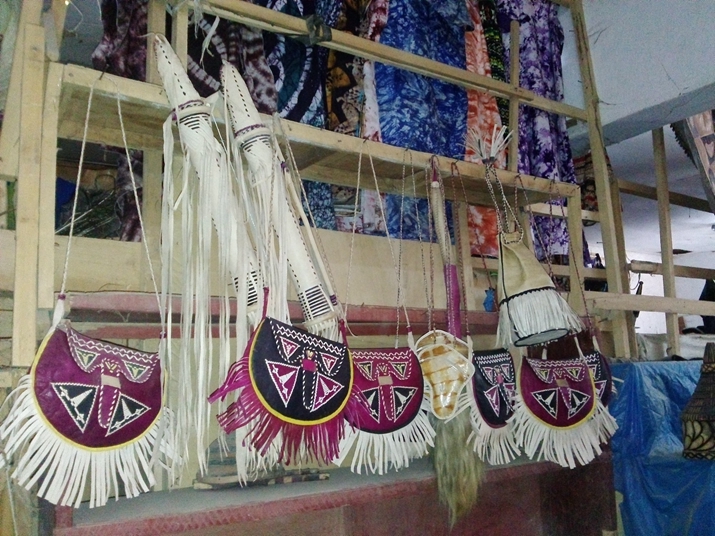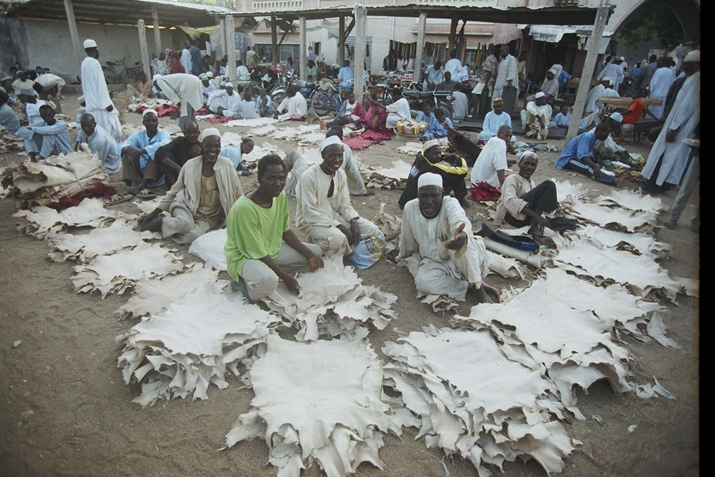|
||||||||||
| Home Nation World Business Opinion Lifestyle ChinAfrica Multimedia Columnists Documents Special Reports |
|
||||||||||
| Home Nation World Business Opinion Lifestyle ChinAfrica Multimedia Columnists Documents Special Reports |
| ChinAfrica |
| A craft industry of processing cattle horns and hides brings a stable income to the youth of Cameroon |
| By François Essomba ChinAfrica ·2020-08-24 |

Women's handbags made from cattle leather (COURTESY)
For over two centuries, the horns and hides of cattle in north Cameroon have traditionally been among local resources for manufacturing many craft objects for daily use, such as combs, boxes, sandals and handbags.
But with time comes innovation, cattle horns and hides are now being transformed into chairs, tables and carpets, to name but a few. Moreover, this innovative and eco-friendly manufacturing model has a positive impact on the environment, since using cattle horns and hides for artisanal purposes contributes to reducing local pollution.
This craft form also shines a spotlight on the techniques, knowledge and skills of local artisans in Maroua City. Marketing campaigns have also ensured the range of items are sold locally, as well as beyond the shores of Cameroon.
Thriving business chain
To optimize the supervision of the craft sector, as well as to increase its visibility and promote local craft activities carried out by young people in the far north region of Cameroon, local government constructed a museum dedicated to the crafts in Maroua City, which was inaugurated on December 15, 2015.
The museum is a space entirely dedicated to the production and display of local cultural and craft products. In the museum and in the surrounding areas, merchants, wholesalers and retailers offer sandals, shoes, purses, handbags, clothing and many other objects and pieces of furniture made from recycled materials.
Near the craft museum, tanners of cattle skins transform rawhide into leather. Some of the leather is sold to local buyers, and the rest is purchased entirely by wholesalers, who in turn resell them to furniture designers and other artisans. It is therefore a well-organized, thriving business chain in the regional capital.
Financial opportunities
The transformation of animal parts, such as cattle hides and horns, has provided young Cameroonian artisans with an opportunity to find employment and earn a significant income for themselves, their families and their community. Profit generated by the craft industry also contributes to the urban rejuvenation of Maroua City, as well as of the entire far north region of Cameroon.
Djibrila Oumarou, 30, is a young artisan who regularly visits the slaughterhouse not to buy meat, as other usual customers do, but to collect discarded cattle horns. After selecting the best horns, Oumarou brings them to his workshop where they are cleaned, sanded and prepared for use. He has been using this raw material to design and manufacture furniture for more than a decade in the craft museum workshop.
Abdel Wahab, a well-known wealthy businessman from the local area, purchased a seven-seater lounge furniture set and a carpet from Oumarou for $750. “I came to buy chairs. I saw that these chairs are very comfortable and beautiful. I have never seen such good chairs. Here in Maroua, they can make great furniture from cattle horns and leather. It’s really great,” said Wahab.

A market selling cattle hides in Maroua City, where artisans come to get their supplies (COURTESY)
Bright business sector
Many young people involved in the manufacturing sector do not hide their pride in creating craft using cattle horns and leather. However, the young artisans are quick to note that their profession requires precise skills and a great deal of concentration and patience to excel. Moreover, the craft trade can bring a significant income to the best artisans.
The knowledge of the local craftsmen is well known and recognized beyond their home city. Indeed, a number of national and international trade fairs have already invited these young artisans to attend and show their creations.
For example, 29-year-old craftsman Issa Mahamat said he regularly takes part in a number of cattle trade fairs in Cameroon, as well as in other countries in the Central Africa region. “Our leather creations are as good as those coming out of factories, which has enabled me to be invited to attend certain major fairs. And I take advantage of these platforms to present my knowledge of my craft to many visitors. I receive a lot of orders during these fairs. So, it’s a well-paying job. For example, if I spend $350 on the purchase of materials for manufacturing a seven-seater living room furniture set, and I work on it for a month, I can sell it for at least $750; so you can see the kind of profit I can make. And in a year, I can sell dozens of furniture sets of different values,” he said.
Ibrahim Arouna, 32, has been working in the craft industry for more than a decade. He has perfected the art of using cattle horns and leather as materials, a readily available resource in his hometown. In fact, all over north Cameroon, large-scale farming, including cattle, goats, sheep farming, is a pillar of the local economy.
After getting the cattle leather and horns he needs at the market, Arouna then proceeds to transform the horns. The preparatory phase takes him three to four days, during which he makes horns as malleable as possible. Then comes the design and arrangement of wood and leather to create in the end product of a brand new and beautiful piece of furniture.
Financially, this craft trade allows Arouna to earn a significant income and provide well for his family. The young craftsman also said that his turnover fluctuates between $6,000 and $7,000.
The local Maroua City University also supports the industry. Its training school, called the Higher Institute of the Sahel, sends its Fine Arts students to do a professional internship in local cattle horn craft workshops. Every year, three to four students study under the supervision of these self-taught craftsmen. As such, the students can learn more about this specific and unique industry directly from these craftsmen who demonstrate, on a daily basis, mastery of their craft.
(Print Edition Title: Cameroon's Creative Crafts)
(Reporting from Cameroon)
Comments to liuwei@chinafrica.cn
| About Us | Contact Us | Advertise with Us | Subscribe |
| Copyright Beijing Review All rights reserved 京ICP备08005356号-5 京公网安备110102005860号 |